The color of an animal’s blood is largely determined by the presence of certain transport proteins. Hemoglobin, for instance, gives humans and most other vertebrates our distinctively deep red-colored blood. If their blood contains another type of protein, however, some animals can have red, blue, purple, or even green blood! Animals with hemocyanin in their blood, for example, generally have blue blood. Read on to learn all about the 10 main types of animals with blue blood below!
1. Spiders

Spiders like this jumping spider have blue hemolymph. Hemolymph is a circulatory fluid present in most invertebrates, and it’s similar to blood.
©pratan ounpitipong/Shutterstock.com
We’ll start our list with spiders, a blue-blooded animal with more than 50,000 documented species! Specifically, their blood–technically a blood-like substance present in many invertebrates called hemolymph–is a pale blue shade.
Also like most other invertebrates, spiders have open circulatory systems. This means blood, or rather hemolymph, flows freely through spaces in the body rather than via blood vessels and veins. These spaces around the spider’s organs are collectively called the hemocoel.
To further allow quick and efficient hemolymph flow, spiders (as well as other arachnids like scorpions) have unique respiratory organs known as “book lungs.” These lungs have many thin, stacked plates with air pockets in between, making them look like the pages of a book. This maximizes the lungs’ surface area, allowing them to exchange respiratory gasses with their environment–and breathe–as easily and efficiently as possible.
2. Octopuses
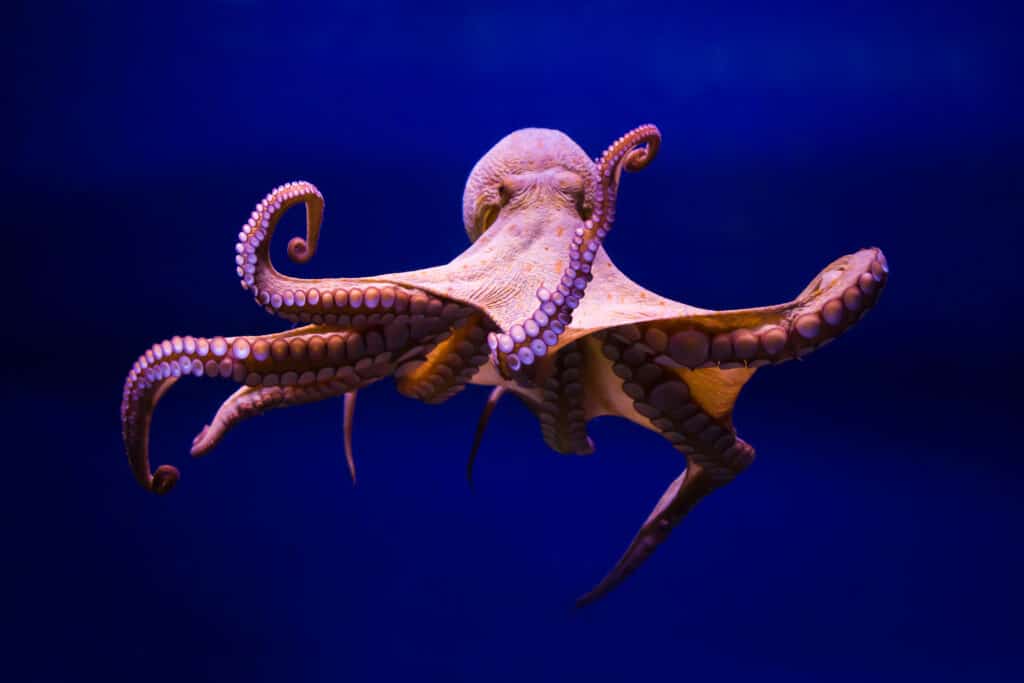
Octopuses (as well as their squid brethren) also have blue blood thanks to the protein hemocyanin.
©iStock.com/:TheSP4N1SH
As we’ll cover in more detail below, both octopuses and squids also have blue blood! They have a lot of it–and they need it, considering their circulatory systems have three hearts.
It turns out these three hearts are equally important. One, the systemic heart, pumps oxygenated blood through the octopus’ body. The other two are branchial hearts that help to take that oxygenated blood and pump it over the animal’s gills. Unlike the aforementioned spiders, octopuses have closed circulatory systems, meaning their blood flows to the rest of their bodies via blood vessels.
In addition to having three hearts, octopuses also have nine brains! They have one central brain in their head, while each one of their eight arms also possesses a much smaller brain to allow each arm to work independently. Octopus bodies are quite complex!
3. Squids
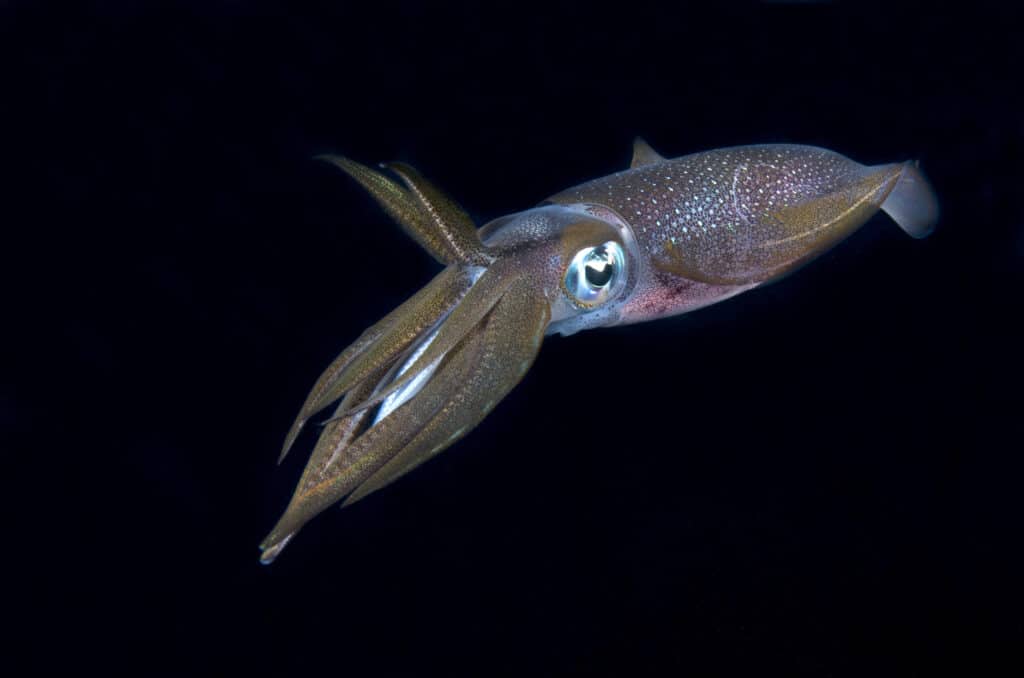
Just like octopuses, squids like this bigfin reef squid also have blue blood.
©iStock.com/DiveIvanov
Squids are rather closely related to octopuses. They share the same taxonomic class, Cephalopoda, which also includes the nautilus and cuttlefish. Like the octopus, squids also have blue blood. They also have closed circulatory systems in which blood flows through vessels to be delivered to the rest of the body.
The squid’s circulatory system is similarly complex and boasts three hearts. As water enters the squid’s mantle, it flows over the squid’s gills. Oxygen from the water gets pulled into the blood with the help of the branchial hearts. Next, the systemic heart, which has three unique chambers, pumps the oxygenated blood to the rest of the body.
Thanks to hemocyanin, squid blood is a rich shade of blue. It contains copper and becomes blue when it binds to oxygen. When oxygen is not present, it is colorless!
4. Horseshoe Crabs
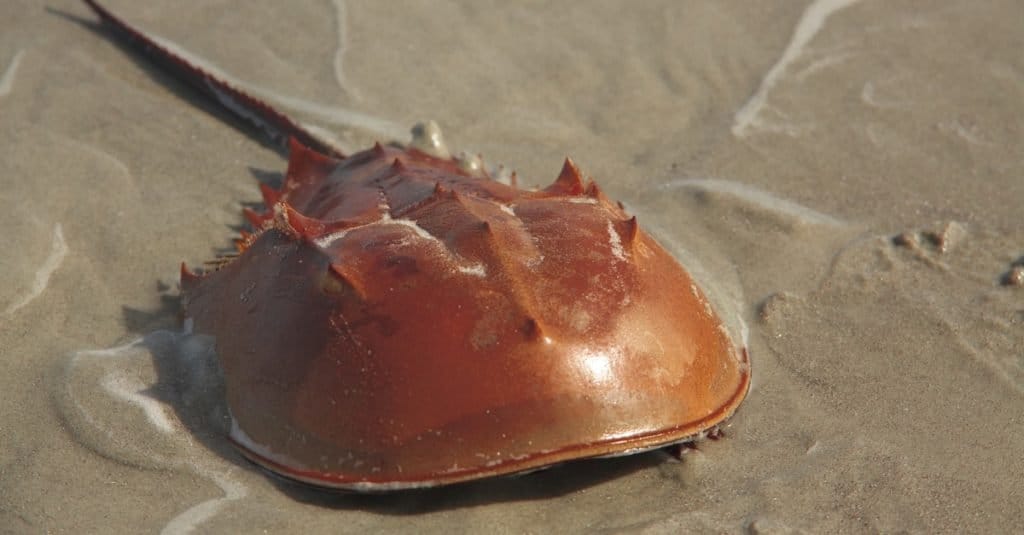
Horseshoe crabs have book gills to help deliver oxygen to the rest of their bodies. The book lungs present in spiders likely evolved from book gills.
©SandraG/Shutterstock.com
Although they look rather primitive and downright alien-like, horseshoe crabs have surprisingly developed and complex bodies. This extends to their circulatory systems, which are full of bright blue blood. Unlike the whopping three hearts boasted by the squids and octopuses above, horseshoe crabs have a single, long, roughly tube-shaped heart running vertically down the length of their bodies.
Similar to the book lungs of spiders, horseshoe crabs have what are known as book gills. Most evolutionary scientists believe the book lungs present in spiders’ and scorpions’ bodies evolved from book gills at some point.
As blood flows over the surface of the horseshoe crab’s book gills, the individual “flaps” or “pages,” better known as lamellae, sort of wave back and forth to help circulate blood to the rest of the body.
5. Snails
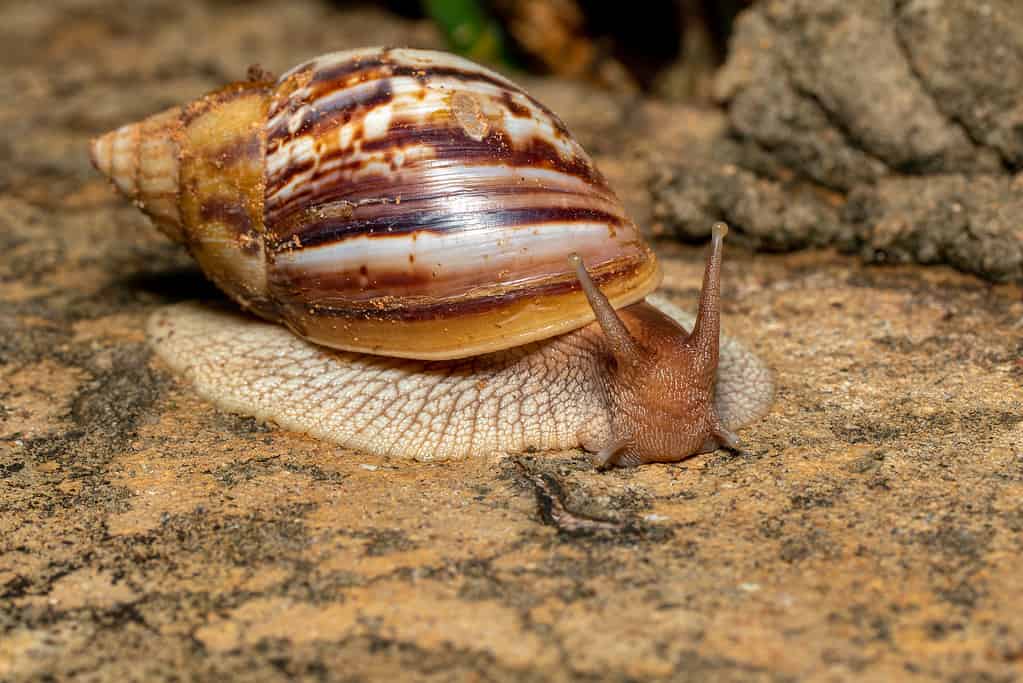
Snails like this
giant African land snail
have open circulatory systems.
©Artush/iStock via Getty Images
The next member of the elite blue-blooded animal club is the humble snail. Snails have open circulatory systems where hemolymph flows through the body cavity and directly over the body’s tissues instead of through vessels.
Most snails have a single heart with two chambers. These chambers, the auricle, and ventricle, pull hemolymph from a gill or lung (depending on the species) and deliver it to the snail’s aorta. The aorta is the largest artery in the body, both in snails and many vertebrates like us humans!
Notably, snail aortas are quite short compared to those of most other animals. It divides into two vessels that supply blood to the rest of the snail’s body. One of these vessels supplies blood primarily to the snail’s head and massive foot. Meanwhile, the other vessel helps transport blood to the other body tissues and organs.
6. Lobsters

Lobsters’ hearts have only one chamber.
©davemhuntphotography/Shutterstock.com
The next uniquely blue-blooded animal we’ll touch on is the lobster. Like the snail we just covered above, it also has an open circulatory system. Interestingly, the heart of a lobster has not two or three chambers, but just one. However, it contains many long, thin muscles with lots of small openings, or ostia, throughout.
A lobster’s heart is encased in a thin membrane called a pericardium. As blood passes over the pericardium, it flows into the heart’s ostia. From here, the ostia begin to contract. This raises the pressure within the heart, which allows the arteries’ valves to open and blood to flow to the rest of the lobster’s body.
After the ostia contract, the heart relaxes, resulting in pressure within the heart dropping. The arteries’ valves close, and the heart sort of contracts. The ostia then opens again, allowing hemolymph to enter once more from the pericardium.
7. Clams

Clams have single, two-valved hearts.
©Jay Ondreicka/Shutterstock.com
Another blue-blooded animal you might not expect to see on this list is the clam. Like many of the animals mentioned here, clams have open circulatory systems, as they lack veins and blood vessels entirely.
Clams have quite sedentary lifestyles once they are adults, so their bodies don’t need to work very hard to exchange oxygen and other gasses with their environment. Open circulatory systems, as you might imagine, deliver oxygenated blood much more slowly than closed ones. True to their taxonomic class name, Bivalvia, clams have a single heart with two valves.
Because their bodies are quite small and primitive, the organs of clams are packed rather tightly together in a visceral mass or complex. The heart is also housed within a pericardium, which resembles a thin, fleshy sac just above the gills.
8. Cuttlefish
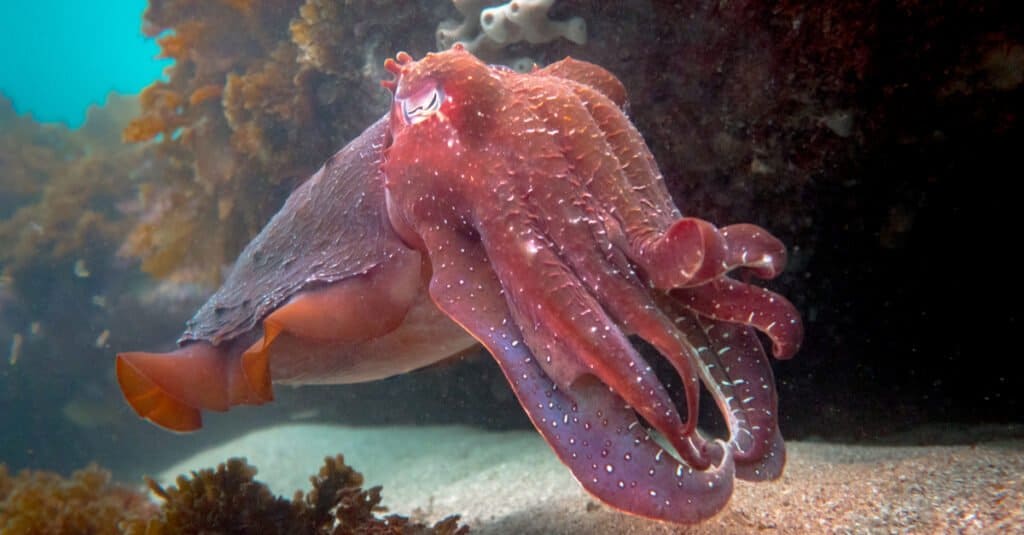
Like squids and octopuses, cuttlefish also have three hearts. Two are branchial, while the other is systemic.
©Ste Everington/Shutterstock.com
Because they are closely related, the circulatory system of a cuttlefish is very similar to that of an octopus or squid. Cuttlefish also have three hearts, two of which are branchial, while the other is systemic. Overall, they function the same as those of squid and octopuses. The two branchial hearts push blood to the gills. Meanwhile, the systemic heart pumps oxygenated blood to the rest of the cuttlefish’s body.
9. Scallops

Scallops are among the only free-swimming bivalves; however, they still have open circulatory systems.
©Gill Copeland/Shutterstock.com
Scallops are very similar to clams, as they belong to the same taxonomic class, Bivalvia. While clams generally stay in one spot as adults, however, clams can swim freely. Like clams and most bivalves, scallops also have open circulatory systems, as their bodies do not need vessels to transport oxygenated blood.
Scallops have bluish-green blood that simply flows over their organs and tissues freely instead of via vessels. Notably, their respiratory systems can be quite fragile, due to their higher respiration rate compared to other bivalves. This higher respiration rate can largely be attributed to the scallop’s free-swimming ability.
10. Certain Types of Frogs
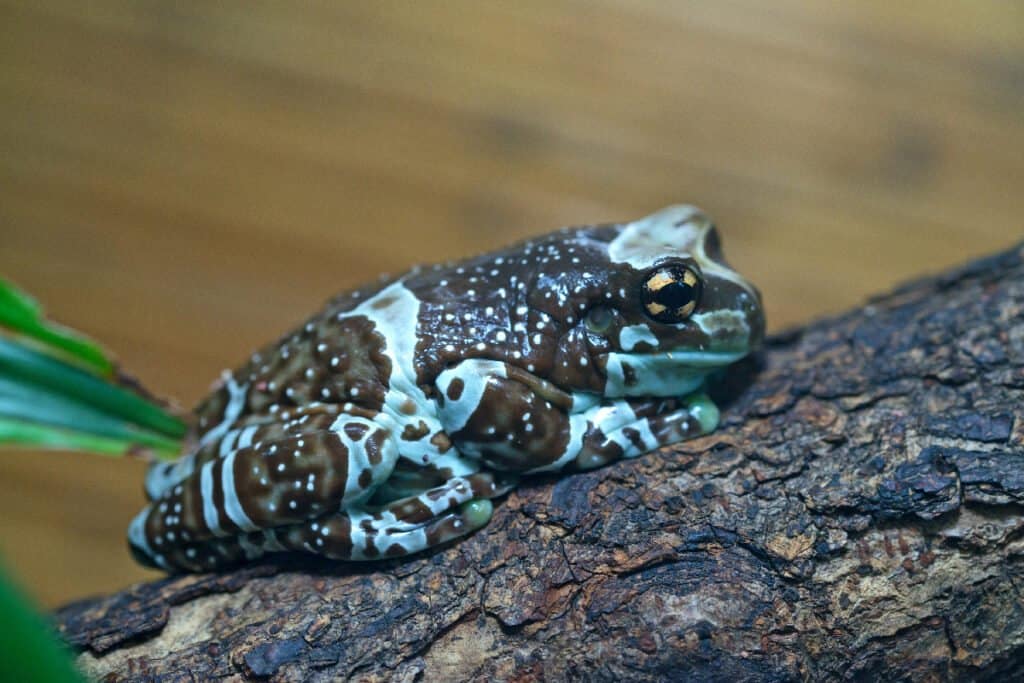
The blood of the Amazon milk frog is blue thanks to the bile pigment biliverdin.
©iStock.com/Oskanov
Frogs are something of an outlier among the other animals with blue blood on this list. This is because the vast majority of frog species have red blood thanks to the presence of hemoglobin. However, one brightly-colored species stands out among the rest: the Amazon milk frog.
The blood of these unique frogs isn’t blue due to hemocyanin like the other animals listed here, either. It’s blue-tinged thanks to high amounts of the bile pigment, biliverdin. Additionally, they have translucent skin, which allows their blue blood to appear especially vibrant, even from a distance! Interestingly, their bones and muscles also take on a bluish tinge thanks to this bile pigment.
The photo featured at the top of this post is © iStock.com/:TheSP4N1SH
Thank you for reading! Have some feedback for us? Contact the AZ Animals editorial team.







